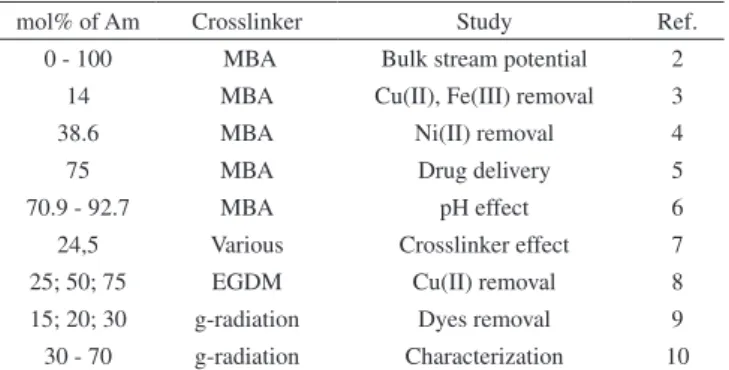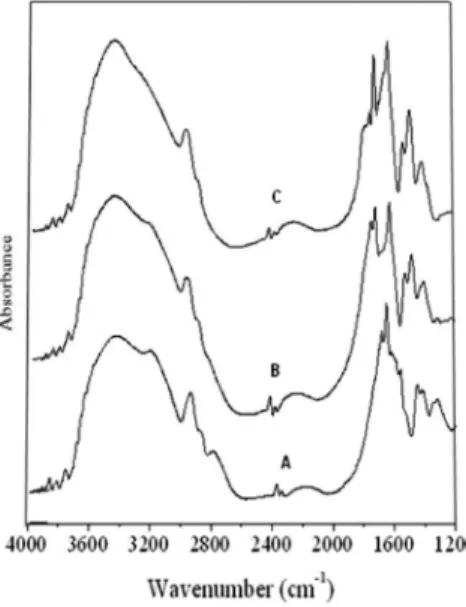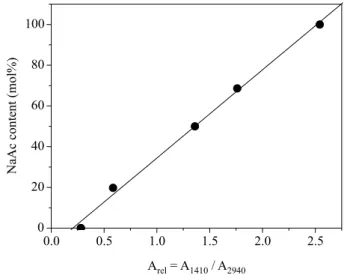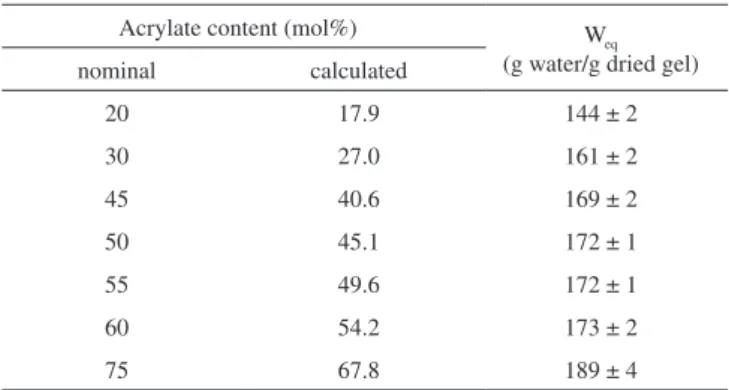Quim. Nova, Vol. 35, No. 7, 1464-1467, 2012
Nota Técnica
*e-mail: judith@dqoi.ufc.br
APPLICATION OF FTIR IN THE DETERMINATION OF ACRYLATE CONTENT IN POLY(SODIUM
ACRYLATE-CO-ACRYLAMIDE) SUPERABSORBENT HYDROGELS
Antônio Sávio G. Magalhães
Curso de Química, Faculdade de Educação de Itapipoca, Universidade Estadual do Ceará, 62500-000 Itapipoca - CE, Brasil
Manuel P. Almeida Neto
Instituto Federal de Educação, Ciência e Tecnologia do Rio Grande do Norte, Campus Caicó, 59300-000 Caicó - RN, Brasil
Maslândia N. Bezerra, Nágila M. P. S. Ricardo e Judith P. A. Feitosa*
Departamento de Química Orgânica e Inorgânica, Universidade Federal do Ceará, CP 6021, 60455-760 Fortaleza - CE, Brasil
Recebido em 25/11/11; aceito em 30/1/12; publicado na web em 15/6/12
Hydrogels have been prepared by free-radical solution copolymerization of acrylamide and sodium acrylate (NaAc), with molar ratio ranging from 25/75 to 80/20, respectively, using methylene bisacrylamide as the crosslinking agent. A FTIR spectroscopy procedure to determine the acrylate/acrylamide ratio in these hydrogels was proposed based on absorbance at 1410 cm-1 (νCOO-) and 2940 cm-1 (νCH and νCH2). A straight line with a good linear correlation coefficient (0.998) was obtained by plotting the acrylate content (Ac%) versus relative absorbance (Arel = A1410/A2940). Results were confirmed by the amount of sodium cation released in acid medium determined by atomic absorption spectrometry.
Keywords: hydrogel; sodium acrylate; FTIR.
INTRODUCTION
Anionic superabsorbent hydrogels based on acrylic acid (HAc) or sodium acrylate (NaAc) and acrylamide (Am) are well known, extensively studied and produced on a large scale.1 Hydrogels can
swell to absorb huge volumes of water or aqueous solution and are widely employed in sanitary applications, such as diapers and tampons and as a soil conditioner in agriculture for retaining soil moisture in arid areas. Despite being in use for a long period, interest in these hydrogels remains, as can be seen in Table 1.
There is also interest in composites of poly(acrylamide- co--acrylate) and clays (hydrotalcite,11 bentonite),12 composites with rice
husk ash13 and grafts with polysaccharides (starch,14
carboxymethyl--cellulose,15 cashew gum16).
Hydrogels based on acrylate and acrylamide can be synthesized in different ways: a) mixture of acrylamide and acrylate;4,12 b)
acryla-mide plus acrylic acid followed by neutralization with NaOH;3,7,10
c) hydrolysis of acrylamide gel with NaOH;17,18 and hydrolysis of
polyacrylonitrile with NaOH.14 All hydrogels, except those obtained
by method “a”, will need a definition of the precise amount of ionic charge. Even in this method, the real ratio of monomeric units can change because, depending on their origin, monomers contain diffe-rent amounts and kinds of stabilizer agents, not always eliminated from starting materials.
Elemental analysis was the only method cited in the literature for determining degree of hydrolysis of polyacrylamide hydrogel18
and amount of acrylamide in poly(HAc-co-Am) hydrogel.8,10 In both
cases, carbon and nitrogen percentages are those employed in the calculation. Nitrogen is an element from acrylamide while carbon is from all the monomers (acrylamide and acrylic acid or acrylate) and also from the cross-linking agent. The C%/N% ratios measured in poly(HAc-co-Am) hydrogels were significantly different from the theoretical values.8 For example, the C%/N% theoretical value for
a hydrogel with 75:25 HAc:Am was 8.54 versus the experimental value of 10.44.8
Fourier transform infrared (FTIR) spectroscopy is one of the most widely employed techniques for analyzing polymeric materials.19
It is a suitable tool to characterize crosslinked materials, such as hydrogels, taking into account that it is not necessary to dissolve the material, and in this case, impossible to achieve in a non-destructive way. For hydrogels based on acrylic acid or acrylate and acrylamide, FTIR has been used to: confirm the presence of monomers and cross-linker in the copolymer chemical structure;5,12,14,15 to verify the partial
neutralization of acrylic acid monomer;10 to corroborate intercalation
onto silicate layers;11 and to investigate intermolecular interaction
between metal ions and hydrogel functional groups.3,8 The degree of
hydrolysis of polyacrylamide hydrogels was also roughly calculated by FTIR spectroscopy.18
Since ionic content is one of the most important parameters that affect swelling, knowledge of the real acrylamide/acrylate ratio in these hydrogels is a subject of interest. The aim of the present work was to report a procedure to determine acrylate/acrylamide ratio in poly(sodium acrylate-co-acrylamide) hydrogels, based on the widely used spectroscopic technique of FTIR.
Table 1. Recent studies ofhydrogels based on acrylic acid/sodium acrylate and acrylamide (Am)
mol% of Am Crosslinker Study Ref. 0 - 100 MBA Bulk stream potential 2
14 MBA Cu(II), Fe(III) removal 3
38.6 MBA Ni(II) removal 4
75 MBA Drug delivery 5
70.9 - 92.7 MBA pH effect 6
Application of FTIR in the determination of acrylate 1465
Vol. 35, No. 7
EXPERIMENTAL
Materials
Acrylamide (Am), acrylic acid, potassium persulfate (KPS) and N,N,N´,N´-tetramethylethylenediamine (TEMED) were obtained from Merck. N,N’-methylene bisacrylamide (MBA) was purchased from Sigma. Sodium acrylate (NaAc) was prepared by neutralization of acrylic acid with NaOH, up to pH 7.0 in an ice bath.20 A solution
at 3 mol/L concentration was obtained for further utilization. All materials were used as received. Distilled water was used throughout all experiments.
Hydrogel synthesis
Hydrogels were synthesized by free-radical copolymerization, following the method of Okay et al.21 and Jeon et al.22 with slight
modifications while keeping the quantity of MBA, KPS and TEMED at a constant value of 0.5, 0.1 and 0.1 mol%, respectively, based on the total quantity of monomer. Gels were prepared, with molar ratio of Am to NaAc ranging from 0/100 to 100/0.
All gels were prepared as follows: an adequate volume of 3 mol/L Am freshly prepared aqueous solution, MBA (7.6 mL at 0.1 mol/L) and KPS (1.52 mL at 0.1 mol/L) were added to an adequate volume of 3 mol/L aqueous NaA. The total volume of monomers solutions was kept at 50.0 mL. More specifically, the volumes of Am and NaAc solutions for the preparation of Gel (25/75) were 12.5 and 37.5 mL, respectively. The system was kept under stirring until complete dis-solution of species. The volume was increased to 50 mL with distilled water. Nitrogen was bubbled through for 10 min followed by the ad-dition of 0.57 mol/L TEMED (250 µL). The system was kept under further stirring until reaching the gelling point, defined as when the magnetic bar could no longer stir.
After 24 h rest, the material was grated, washed several times with a mixture of ethanol:water at the proportion of 2:1 by volume and dried in an oven at 70 °C. The material was sieved in order to obtain samples with particles sizes in the range of 100 to 240 µm (9 to 24 mesh).
Infrared spectroscopy studies
The Fourier transform IR spectra (FT-IR) of dried gels were recorded with a Shimadzu IR spectrophotometer (model 8300) in the range of 400 and 4000 cm−1 as a KBr pellet. In order to determine
the real ratio of NaAc/Am, homopolymers of acrylamide and sodium acrylate were synthesized, without addition of the crosslinked agent. FT-IR spectra of mixtures of PAm and PNaAc at a mol ratio similar to that of hydrogels were also recorded.
Atomic absorption spectrometry
A sample of around 50 mg of hydrogel containing copolymer of 50% of both Am and NaAc (Gel 50/50) was immersed in 100 mL of distilled water at room temperature (25-27 ºC) for 10 days to assure equilibrium was reached. An aliquot of the outside solution was analyzed by atomic absorption spectrometry on a Varian spectro-photometer model Spectra A 55 to quantify sodium ion present. The same procedure was adopted with the immersion of the hydrogel in HCl at pH 2 (after the equilibrium in water was reached).
Swelling
A known mass of purified hydrogel in the range of 30-50 mg was
placed inside a pre-weighed sintered glass filter (nº 0) and covered with distilled water at room temperature (31 ± 1 °C) until swelling equilibrium was reached. The glass filter was then removed from the water, and excess water drained by gravity for a few minutes. The external and internal contained walls not in contact with the gel were dried and the system re-weighed.
The degree of swelling equilibrium (Weq) was determined by
Equation 1:
(1) where msw and mdr are the masses of swollen and dry polymer,
res-pectively. All swelling experiments were repeated at least three times.
RESULTS AND DISCUSSION
FT-IR analysis
The spectra of Gel (50/50), homopolymeric Gel (Am) and Gel (NaAc) are depicted in Figure 1. Table 2 lists the attribution of the main bands.23 As expected, the Gel (50/50) spectrum is composed of
bands from Gel (Am) and Gel (NaAc). The bands at 3410-3421 cm-1
(νas NH2), 3190-3194 cm-1 (νs NH2) and 1682-1685 cm-1 (n C=O) are
characteristics of the acrylamide unit. Bands at 1560 and 1406-1410 cm-1 are due to carboxylate group stretching of acrylate. The presence
of a weak band at 1710 cm-1 in Gel (NaAc) indicates a small fraction
of the COOH group not totally neutralized in the first step of synthesis. The shoulder in the same region also suggests the presence of COOH in the copolymer hydrogel. The presence of adsorbed water can be seen by the band at 3300 cm-1 in all spectra. At 1653-1654 cm-1, a
stretching of the C=O group from the acrylamide unit appears in Gel (Am) and Gel (50/50) spectra. At this wavenumber there is also the OH angular deformation from water, which explains the existence of this band in the polyacrylate spectrum. The stretching vibrations of carboxylate of the acrylate unit and CN from acrylamide unit are superposed at 1406-1410 cm-1.
The first step of the method was the synthesis of polyacrylamide (PAm) and poly(sodium acrylate) homopolymers. Spectra of PAm, PNaAc and a mixture of two, were obtained in a KBr pellet. The mixture was done in order to obtain mol% of acrylate, in relation to
Magalhães et al.
1466 Quim. Nova
total amount of monomers from PAm and PNaAc, assumed as 100%. The band assigned to the carboxylate group at 1410 cm-1 was utilized
as standard. To avoid difference in polymer concentration within the KBr pellet, relative absorbance was calculated in relation to the band at 2931-2944 cm-1, assigned to CH and CH
2, taken as constant. The
way in which the baseline of the two bands was drawn and absorbance was calculated is depicted in Figure 2.
A straight line with a good linear correlation coefficient (R = 0.998) was obtained by plotting the acrylate content (Ac%) versus relative absorbance (Arel = A1410/A2940) obtained from the mixture of
PAm and PNaAc (Figure 3). The relative absorbance in zero acrylate content is due to the absorbance of the CN group of acrylamide. The equation obtained from a linear fit was:
Ac% = - 8.83 + 43.2 Arel (2)
Real acrylate content (Acreal, in mol%) of hydrogels was calculated
from Arel and Equation 2. The correlation between the calculated and
nominal acrylate content (Acnominal, in mol%) was demonstrated by the
line shown in Figure 4. A good linear fit can be seen, with R equal to 0.9999. The equation is the following:
Acreal = 0.046 + 0.903 Acnominal (3)
According to Durmaz and Okay,20 the linear dependence suggests
that the monomeric units are randomly distributed in the polymeric chain. These authors found similar results with hydrogels based on acrylamide and 2-acrylamide-2-sodium methyl propanesulfonate.
The calculated acrylate content from a linear fit is shown in Table 3. All calculated values are lower than nominal levels. To compare results, the Gel (50/50) was immersed in acidified water (pH 2) until equilibrium was reached. The amount of sodium released was determined by atomic absorption spectroscopy. Sodium in water was 1.5 mg/100 mL and in pH 2.0 was 5.52 mg/100 mL. Taking into account that each acrylate group in the hydrogel is neutralized by one sodium ion, and that all Na+ was substituted by H+, the released
cation can be correlated with acrylate content. Based on this assump-tion the acrylate content is 45.3 mol%, very close to the 45.1 mol% calculated by FTIR.
Comparing nominal with calculated acrylate content, a differ-ence of 10 ± 0.3% or less in calculated content was observed for all hydrogels. The difference is independent of NaAc content and can be correlated with monomer reactivity ratio. Chauhan and Kumar24 found
that the reactivity of acrylic acid was greater than that of acrylamide in poly(HAc-co-Am) hydrogels. Hence, the probability of HAc enter-ing into the copolymer chain is higher compared to Am. Therefore, even with the addition of an equal mole amount of co-monomer, the Table 2. Attribution of main bands in FTIR spectra of Gel(Am), Gel(50/50)
and Gel(NaAc) Hydrogel
Assignment23 Gel(Am) Gel(50/50) Gel(NaAc)
3410 3421 - νas NH2 of acrylamide unit 3300 3300 3300 υ OH of adsorbed water 3190 3194 νs NH2 of acrylamide unit 2931, 2860 2941, 2860 2944, 2860 νCH and νCH2
- - 1710 ν C=O of acrylic acid 1685 1682 - ν C=O of acrylamide 1654 1654 1653 νC=O of acrylamide and δ OH of
water - 1560 1560 νasCOO- of Na-acrylate 1410 1406 1410 νsCOO- of Na-acrylate / υ CN of
acrylamide
Figure 2. Bands and way utilized for the calculation of relative absorbance, Arel = A1410/A2940
Figure 3. Calibration plot of acrylate content versus A1410/A2940 obtained from
mixture of homopolymers (polyacrylamide and sodium polyacrylate)
Application of FTIR in the determination of acrylate 1467
Vol. 35, No. 7
Table 3. Comparison between calculated and nominal acrylate content in hydrogels and their respective swelling in water
Acrylate content (mol%) Weq (g water/g dried gel) nominal calculated
20 17.9 144 ± 2
30 27.0 161 ± 2
45 40.6 169 ± 2
50 45.1 172 ± 1
55 49.6 172 ± 1
60 54.2 173 ± 2
75 67.8 189 ± 4
hydrogel was richer in HAc. This result is contrary to that found in the present work, showing the hydrogel to be richer in acrylamide. However, sodium acrylate, instead of acrylic acid was employed. Sodium acrylate polymerizes less readily than acrylic acid, because ionized monomers react more slowly in the propagation step of po-lymerization.25 The results found for poly(NaAc-co-Am) hydrogels
indicate that acrylamide is around 20% more reactive than NaAc. As a consequence, reactivity seems to follow the order: acrylamide > sodium acrylate > acrylic acid.
Swelling
The effect of real acrylate content on equilibrium swelling can be seen in Table 3. The PAm hydrogel (0 mol% of NaAc) absorbed 12 ± 1 g water/g gel, much lower than the hydrogel with 18% of NaAc (Weq = 144 ± 2 g water/g gel). At 74% of NaAc, the water absorption
reached 189 ± 4 g water/g gel. There is a substantial increment for the PNaAc, with Weq of 260 g water/g gel. At around 50% acrylate,
an interesting effect was observed with a plateau between 40.6 and 54.2 mol% of NaAc, equivalent to Gel (55/45) and Gel (40/60). The Weq value was 171 ± 2 g water/g gel. A similar effect was reported
previously25 with mole fraction of acrylamide ranging from 0.4 to
0.6. Hydrogels with 18 mol% or more of NaAc are superabsorbent.
CONCLUSIONS
A method for the calculation of acrylate content, based on ab-sorbance at 1410 cm-1 (nCOO-) and 2940 cm-1 (νCH and νCH
2) by
infrared spectroscopy, was proposed and tested for hydrogels prepared by free-radical crosslinking solution copolymerization of acrylamide and sodium acrylate using methylene bisacrylamide as the cross-linking agent. A straight line with a good linear correlation coefficient (R = 0.998) was obtained by plotting acrylate content (Ac%) versus relative absorbance (Arel = A1410/A2940). Excellent linear correlation
between calculated and nominal acrylate content was observed with R higher than 0.9999. These results indicate that the proposed method
is reliable and adequate for calculating acrylate content in hydrogels. An additional conclusion was based on the finding that calculated content of acrylate was consistently lower than the added content of acrylamide, with a difference of around 10% in all cases. Hence, acrylamide is around 20% more reactive than NaAc.
ACKNOWLEDGEMENTS
This work was supported by CT-Hidro, CNPq, FUNCAP and INCT-INOMAT.
REFERENCES
1. Zohuriaan-Mehr, M. J.; Kabiri, K.; Iran. Polym. J.2008, 17, 451. 2. Fiumefreddo, A.; Utz, M.; Macromolecules2010, 43, 5814. 3. Xie, J.; Liu, X.; Liang, J.; J. Appl. Polym. Sci.2007, 106, 1606. 4. Bajpai, S. K.; Johnson, S.; J. Macromol. Sci. 2007, 44, 285.
5. Ray, D.; Mohapatra, D. K.; Mohapatra, R. K.; Mohanta, G. P.; Sahoo, P. K.; J. Biomater. Sci. Polym. Edn.2008, 19, 1487.
6. Turan, E.; Çaykara, T.; J. Appl. Polym. Sci.2007, 106, 2000. 7. Xie, J.; Liu, X.; Liang, J.; Luo, Y.; J. Appl. Polym. Sci. 2009, 112, 602. 8. Orozco-Guareño, E.; Santiago-Gutiérrez, F.; Morán-Quiroz, J. L.;
Hernandez-Olmos, S. L.; Soto, V.; de la Cruz, W.; Manríquez, R.; Gomez-Salazar, S.; J. Colloid Interface Sci.2010, 349, 583.
9. Şolpan, D.; Duran, S.; Torun, M.; Radiat. Phys. Chem. 2008, 77, 447. 10. Tomar, R. S.; Gupta, I.; Singhal, R.; Nagpal, A. K.; Des. Monom. Polym.
2007, 10, 49.
11. Zhang, Y.; Fan, L.; Cheng, L.; Zhang, L.; Chen, H.; Polym. Eng. Sci.
2009, 44, 264.
12. Tao, W.; Xiaoqinq, W.; Yi, Y.; Wenqionq, H.; Polym. Int.2006, 55, 1413. 13. Candido, J. S.; Leitão, R. C. F.; Ricardo, N. M. P. S.; Feitosa, J. P. A.;
Muniz, E. C.; Rodrigues, F. H. A.; J. Appl. Polym. Sci. 2012, 123, 879. 14. Sadegh, M.; Hosseinzadeh, H.; Turk. J. Chem. 2008, 32, 375. 15. Sadegh, M.; Hosseinzadeh, H.; J. Appl. Polym. Sci.2008, 108, 1142. 16. Silva, D. A.; PhD Thesis, Federal University of Ceara, Brazil, 2006. 17. Guilherme, M. R.; Campese, G. M.; Radovanovic, E.; Rubira, A. F.;
Feitosa, J. P. A.; Muniz, E. C.; Polymer2005, 46, 7867.
18. Zhao, Q.; Sun, J.; Lin, Y.; Zhou, Q.; React. Funct. Polym. 2010, 70, 602. 19. Bhargava, R.; Wang, S. Q.; Koenig, J. L.; Adv. Polym. Sci. 2003,163,
137.
20. Durmaz, S.; Okay, O.; Polymer2000, 41, 3693.
21. Okay, O.; Yilmaz, Y.; Kaya, D.; Keskinel, M.; Pekcan, Ö.; Polym. Bull.
1999, 43, 425.
22. Jeon, C. H.; Makhaeva, E. E.; Khokhlov, A. R.; Macromol. Chem. Phys.
1998, 199, 2665.
23. Silverstein, R. M.; Webster, F. X.; Spectrometric Identification of
Organic Compounds, 6th ed., Wiley: New York, 1998.
24. Chauhan, G. S.; Kumar, A.; J. Appl. Polym. Sci.2008, 110, 3795. 25. Kiatkamjornwong, S.; Wongwatthanasatien, R.; Macromol. Symp.2004,



